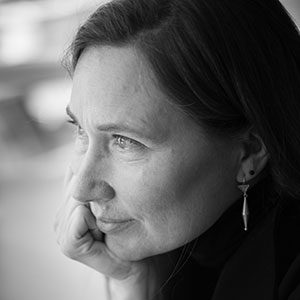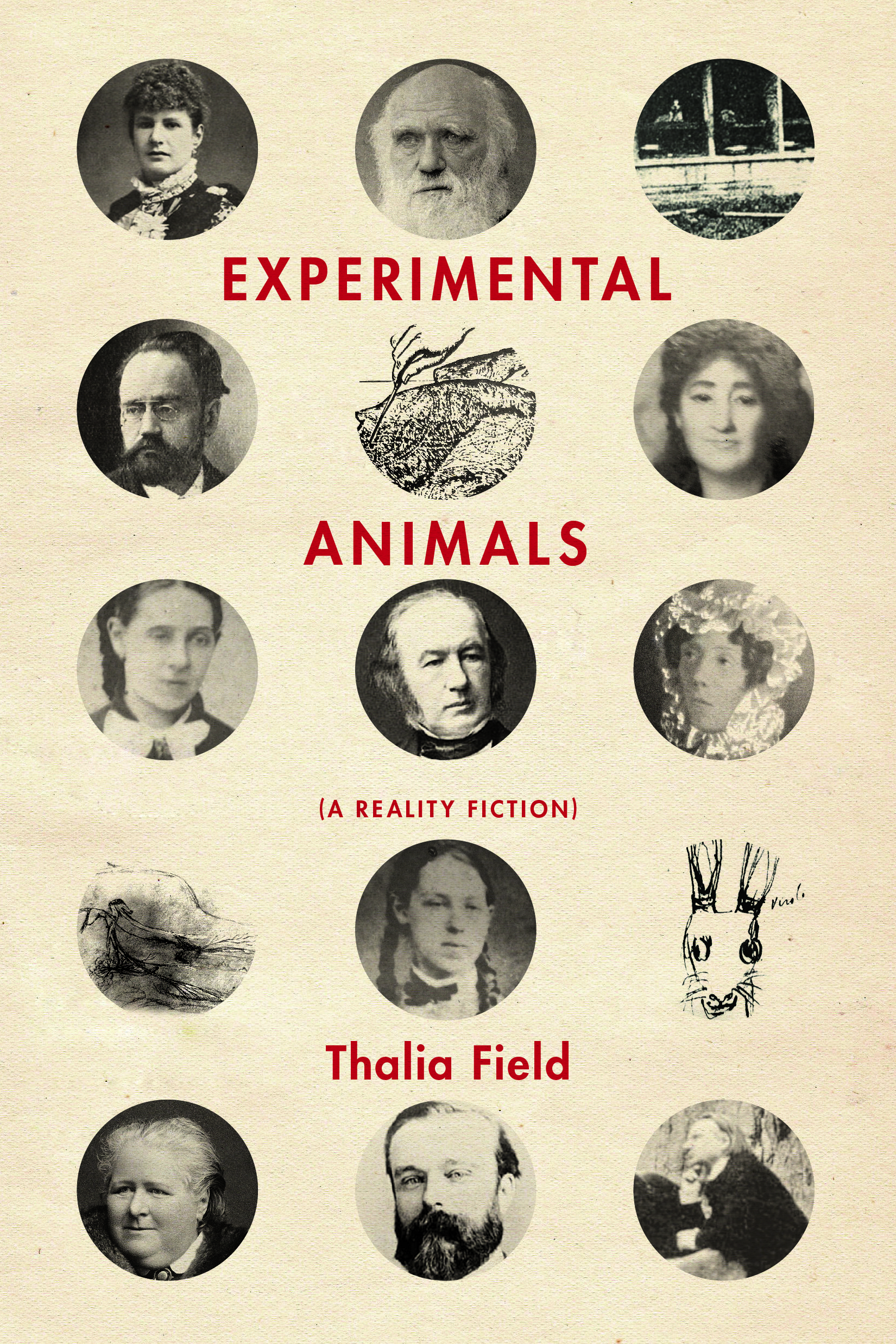
Thalia Field’s latest work, Experimental Animals: (A Reality Fiction), published by Solid Objects, is a novel that makes you wonder anew about the possibilities of the genre. Told in the voice of Marie Francoise “Fanny” Bernard, wife of Claude Bernard, a founder of physiology and zealous practitioner of vivisection, the book is the culmination of over a decade of research and work. Fanny’s voice is startling and poetic, conjuring the horrors of vivisection in poetic images while relating a host of heartbreaks and losses. She spends her evenings rescuing the very animals that would otherwise be captured for vivisection. The intelligence and scope of the book is astounding and awe-inspiring; it collages voices and artifacts, infusing the text with found material, journal entries, written reports, excerpts, photographs, and the like. Its form is monumental, yes, but it is also an unprecedented way to read such histories. Field’s book presents and engages with the relevant literary, cultural, and scientific histories pertinent to the time in such a way that it all makes sense. Were all of our knowledge imagined as Field has done for us, I think I would see the world truly. I had the opportunity to ask Thalia Field some of the larger questions I had about her latest work.
Thalia Field is a professor of Literary Arts at Brown University. Experimental Animals is her sixth book. She has published three collections with New Directions: Point and Line, Incarnate: Story Material, and Bird Lovers, Backyard. Her performance novel, Ululu (Clown Shrapnel), was published with Coffee House Press, and she has two collaborations with French author Abigail Lang: A Prank of Georges (Essay Press, 2010) and the forthcoming Leave to Remain. Before writing books, Thalia worked in theaters in Paris, Berlin, and New York.
***
The Rumpus: Looking through your collection of books, I’m struck by how very different this one is. Of course, this book, to me, carries your signature, but how might you say this book departs from your previous works? How do you see it fitting in with your previous books? How would you describe your novel Experimental Animals as a poetic text?
Field: Experimental Animals continues a few distinct conversations I have been having through writing. First, my interest in “character” (historical, collectively-defined, interdependent) and how incomplete and paradoxical we are: how we are confused with our traces, confused by language, and with how others see us. There is poetry for me in the collision of ideas, in the entanglement of lives. So here I was interested in the dysfunctional marriage of a famous man and an infamous wife, and the live animals (and children) at the center of their “problem.” My other books have explored other narrative “problems”—lately animal problems. I think fundamentally I’ve always been interested in how language befuddles awareness, and obscures or misdirects action. I’m interested in how one ever knows what’s “right,” and, in Experimental Animals, I was interested by the whole gang of characters who each thought (to the death!) that they were absolutely right. This ethical argumentation, this agon, this carnival of opinion and action, is something I think appears in some form in most of my work.
Rumpus: Experimental Animals is a brave undertaking. I say brave, because it seems to me that to engage with the task of simply researching the characters and the history and the science involved would be huge and daunting. And then there’s the writing of the book, which seems a miraculous task. It is a book that I am very much in awe of, and it is a book from which I learned a great deal. When did you first get the idea for Experimental Animals? What was your research and creative process?
Field: I followed myriad research threads—each character, each argument, each mention of something that related to any other aspect of the story or controversies—through many libraries, archives, and other repositories of ephemera. I had tiny pieces without knowing how or if they would connect. There’s a passage about fossils that mirrors how I felt constructing the book. Basically, there were so many bones from so many characters—it felt sometimes impossible to put together a coherent skeleton. What I finally realized was that the negative spaces, the silences in the archives, were as important as what I’d found. The women, the animals, the activists, were not represented on paper or put in “official” records. Yet they existed. This literary and ethical quandary led to my researching statues and other status markers as part of the story itself. Because where do our stories end? Not when we die. The afterimages, the aftereffects of the people—all part of the life stories.
Rumpus: I love the voice of Claude Bernard’s wife, Marie Françoise “Fanny” Bernard, a voice that is yours. So in reading Experimental Animals, no matter how compelling the quoted passages and found material, it is always your voice that I’m seeking, delighting in, underlining, marking. This voice, as we understand from the outset of the book, is one that is from beyond the grave. Fanny’s voice is wrought with conflict, emotion, oftentimes vengeance. Yet it is a beautiful voice full of poetry and imagistic wonders. How do you relate to Fanny? How close are the two of you?
Field: We are the closest of friends, now. At first there was so much of her I didn’t understand, especially her Catholicism. But I found that when I really considered her faith, it was a faith, much like Anna Kingsford’s, that used the figure of Mary to signify the compassion one must have toward circumstances we don’t get to choose or control. It was her Mary-based compassion that I began to understand, and the symbolism of the immaculate conception, and Mary’s role in witnessing Jesus’s death that made her a “mother” to the world. I had to find some understanding of her deepest activist commitments to be able to hear Fanny’s voice. She is angry and vengeful and sardonic. She grows unafraid even as she is put in bad social positions. I think that was really hard on her. She lost something she’d been trained to expect, and had to forge a new way to be. But as her “doubles” appear—Anna Kingsford primary among them—other women begin to make sense of her story. This allows her situation to spread out and gain foundation. Her role becomes many women’s roles, just as Claude’s science spreads. I’m not sure we get to see enough of her daughters because I mostly kept them to what was in the archives. Only Fanny gets let free in that sense.
Rumpus: Claude Bernard gathers animals for vivisection, and Fanny is the rescuer of animals. I see your book doing both of these acts. How does your book operate as a vivisection and also as an act of rescue?
Field: I won’t say my book is a vivisection because I don’t care for the use of that as an analogy. Instead, by using people’s own language in the novel, I hope to put characters back into their own words, to return to them some of their proper texture and tone and point of view. However, I can see that the work, by being a collage, is of necessity in parts and pieces, and the mess I hope to show is not the interior of a living body in pain (as vivisection is), but the social mess of living subjects, each in their own body, each in their own pain, or self-righteousness, or survival. That said, I do hope to illustrate the violence of vivisection, the violence of trying to take life apart and abstract it, the ultimate futility of gaining knowledge through the pain of others, or perhaps the weakness of any form of knowledge that comes at the expense of others. I hope that the book rescues the sense of wonder we might feel before the complexity of life, rescues what we owe to other creatures, especially from incursions of desensitizing language, and rescues history from any one version of it.
Rumpus: How were you able to reflect upon so much death—the deaths of animals as well as the deaths of Fanny’s children and John Brown—and write so beautifully on it?
Field: Experimental Animals as a whole was an exhausting mental and emotional journey. Activists of all sorts put themselves out because they want to stop injustice. The anti-vivisection activists, the many women and men who stood up and made a difference, they were most afraid that instead of stopping injustice and violence they would lose their sense of knowing it was still happening. That to me is the worst nightmare of all—that their prophecy has come true. It’s the not-hearing the cries that is more devastating than being confronted with suffering. Suffering at least asks us to be alive to it, do something, wake up. Claude (historically) compared himself to Sisyphus —who continued to try to escape Death, to control it, dominate it, overpower it. This is the hubris of ignorance that kept me on my toes throughout the book. Each character (historically) compared themselves to a mythological character. They each saw themselves fulfilling a role in their lives. That was a fascinating realm to explore. Who are we in our own minds? What can we endure for the sake of a larger idea?
Rumpus: You write of Claude Bernard: “Writing, he boasts, will become an extension of his experimental work.” It was a writer that Claude wanted to be, but he was known for his medical advances through vivisection. You also mention “Zola’s The Experimental Novel, based on Claude’s Introduction to the Study of Experimental Medicine.” Of course, I have to ask how Experimental Animals is itself “experimental.”
Field: Just as my book, Bird Lovers, Backyard, explores the word “hybridity” and its many connotations in science and literature and history, Experimental Animals explores the word “experimental”—to put some backstory to a phrase we use without too much rigor. I wanted to show that this is a complex history containing real violence, and that animal lives haunt it. I wanted to expose that though experiments are enticing for the freedoms they promise, they also have a dangerous legacy and potential—to elevate the experimenter above all other subjects. Experimental Animals is also in conversation with the origins of realism, both that of Zola and his predecessors, but also that of the activists who used original material from the vivisectors to awaken and confront complacent audiences. The images, the eye-witness accounts, the descriptions and sensational aesthetics, these forms of communication were powerful, and could undermine language used to justify or establish ‘norms.’ This to me is the essence of realism here—to do what needs to be done to bring awareness. Reality does not preclude imagination, dreams, even jokes or disbelief. Reality is the whole experience of being in whatever world one finds oneself, responsible to it. The forms change, the impulse to being awake to the experience of others does not.
***
Author photograph © Benedicte Verley.





